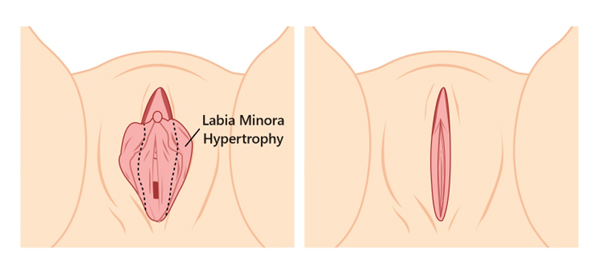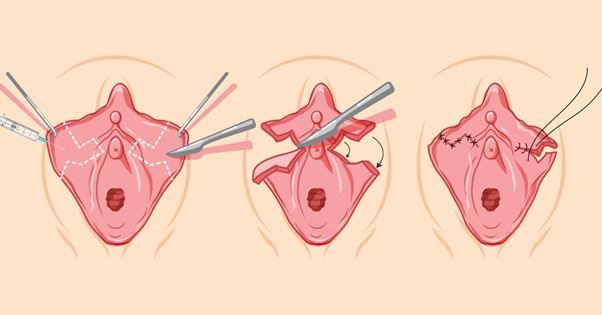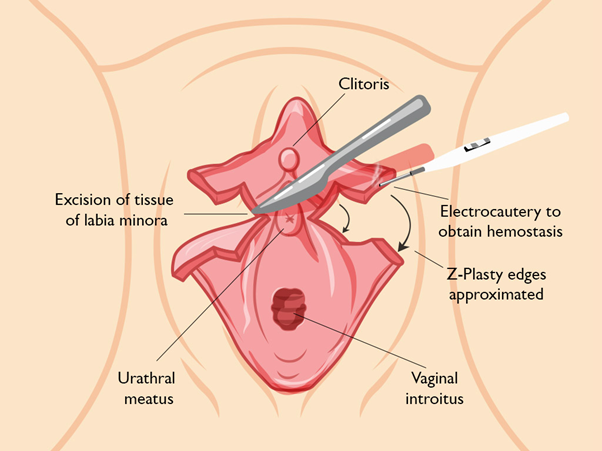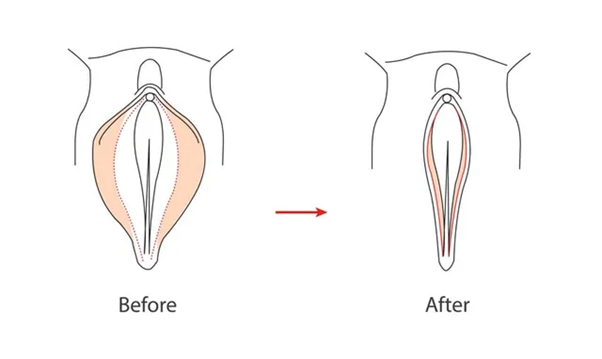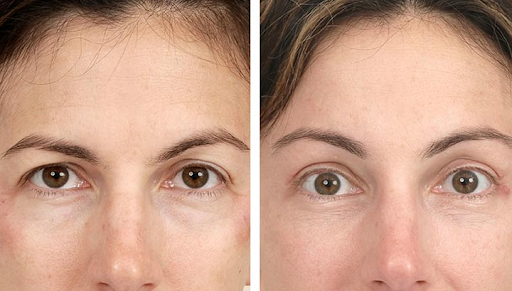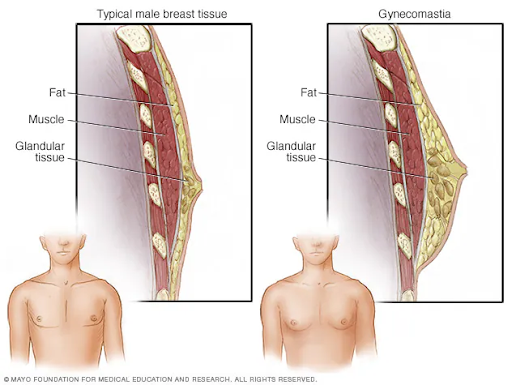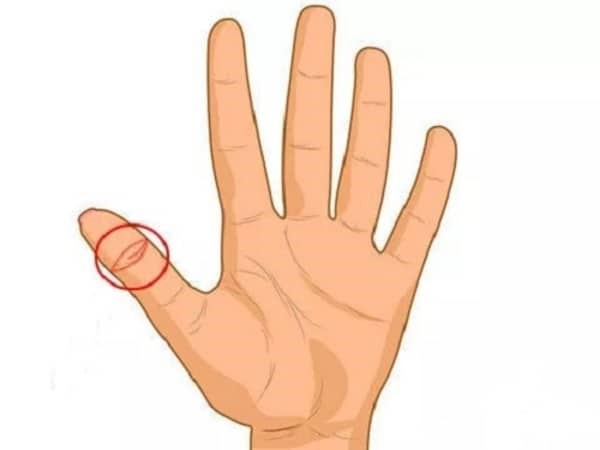Labial minor plasty has gained popularity in recent years due to increasing awareness of body aesthetics and comfort-related concerns. For many women, labial minor plasty is more than just a cosmetic procedure; it represents a way to improve their quality of life, alleviate physical discomfort, and enhance self-confidence. In this comprehensive guide, we will explore what labial minor plasty involves, the reasons why women may consider it, the procedure itself, the recovery process, potential risks, and what to expect from the results.
Labial minor plasty is a surgical procedure which are the inner folds of skin that surround the vaginal opening
What is Labial Minor Plasty?
Labial minor plasty is a surgical procedure designed to alter the shape, size, or symmetry of the labia minora. These are the inner lips of the vulva, located on either side of the vaginal opening, and are distinct from the labia majora, which are the outer lips. The labia minora can vary significantly in size, shape, color, and changes can occur due to factors such as aging, childbirth, hormonal fluctuations, or genetic disposition.
Some women may experience physical discomfort or embarrassment due to enlarged or asymmetrical labia minora, especially during physical activities, sexual intercourse, or even while wearing tight clothing. Labial minor plasty can help address these concerns by reducing the size of the labia minora, creating a more symmetrical appearance, and potentially improving comfort in day-to-day activities.
The labia minora can vary significantly in size, shape, and color from person to person
Reasons for considering Labial Minor Plasty
Below are some of the most common reasons why women choose this procedure:
- Physical Discomfort: Enlarged labia minora can cause discomfort or irritation during physical activities such as cycling, running, or even while walking. Friction from clothing can lead to chafing and soreness, which can be uncomfortable for some women.
- Sexual Discomfort: During sexual intercourse, elongated or uneven labia may cause pain or irritation. Labial minor plasty can help alleviate these issues and make intimate experiences more comfortable.
- Aesthetic Concerns: Many women opt for labial minor plasty for cosmetic reasons. A more symmetrical or smaller labial appearance can contribute to increased self-esteem and confidence, especially when wearing swimsuits, tight-fitting clothing, or during intimate situations.
- Post-Childbirth Changes: Childbirth can cause changes to the vaginal area, including the labia minora. For some women, these changes may lead to physical discomfort or aesthetic dissatisfaction. Labial minor plasty can help restore the labia to a more comfortable and aesthetically pleasing state.
- Emotional Well-being: For some women, the appearance of their labia may affect their self-esteem, body image, and intimate relationships. The goal of labial minor plasty is not only to address physical discomfort but also to improve emotional well-being and overall quality of life.
The decision to undergo labial minor plasty is deeply personal and varies for each individual.
The Labial Minor Plasty procedure
Labial minor plasty is typically performed as an outpatient procedure, which means that patients can go home the same day. The surgery is usually done under local anesthesia, though general anesthesia is also an option for patients who prefer to be completely unconscious during the procedure.
The main steps of the procedure include:
- Consultation: Before surgery, patients will have a detailed consultation with their surgeon. During this consultation, the surgeon will discuss the patient’s goals, evaluate the anatomy of the labia, and recommend the most appropriate technique to achieve the desired results.
- Anesthesia: On the day of the surgery, anesthesia will be administered to ensure comfort throughout the procedure. Depending on the patient’s preference and the complexity of the surgery, local or general anesthesia may be used.
- Trimming and Reshaping: The surgeon will then remove excess tissue from the labia minora. There are different techniques for performing labial minor plasty, such as the trim technique, where excess tissue is removed along the edges, or the wedge technique, where a V-shaped wedge of tissue is removed to maintain a natural contour.
- Closing Incisions: Once the desired reshaping is complete, the incisions are carefully closed with dissolvable sutures. These sutures will gradually dissolve as the area heals, reducing the need for follow-up suture removal.
- Recovery and Aftercare: Patients are given detailed aftercare instructions to ensure proper healing. This may include using cold compresses to minimize swelling, avoiding tight clothing, and abstaining from sexual activity or strenuous physical activities for several weeks.
Labial minor plasty is typically performed as an outpatient procedure, which means that patients can go home the same day.
Recovery processo of Labial Minor Plasty
The recovery process for labial minor plasty is typically straightforward, but it does require some patience and attention to care. Below are some important aspects of the recovery process:
- Pain and Swelling: It is normal to experience some pain, swelling, and bruising immediately following the procedure. Pain medication may be prescribed to manage discomfort, and cold compresses can be applied to minimize swelling.
- Activity Restrictions: Patients are advised to avoid heavy lifting, exercise, and sexual activity for at least four to six weeks. This helps ensure proper healing and minimizes the risk of complications.
- Personal Hygiene: Maintaining good hygiene is essential for preventing infections. Patients should avoid soaking in baths or swimming pools until cleared by their surgeon, and they should gently clean the area as directed.
- Follow-up Appointments: Follow-up appointments with the surgeon are crucial to monitor the healing process and ensure there are no complications. During these visits, the surgeon may also provide additional guidance on resuming normal activities.
Most patients can return to their daily activities within a week, although it may take several weeks for complete healing.
Potential risks and Complications
As with any surgical procedure, labial minor plasty comes with some potential risks and complications. Some possible risks include:
- Infection: As with any surgery, there is a risk of infection, which can be minimized by following the surgeon’s aftercare instructions and maintaining good hygiene.
- Scarring: Although labial minor plasty is designed to minimize scarring, some patients may experience visible scarring. The extent of scarring depends on the surgical technique used and individual healing processes.
- Changes in Sensation: Some patients may experience temporary changes in sensation, including numbness or heightened sensitivity. In most cases, these sensations will subside as the area heals.
- Asymmetry: There is a possibility of slight asymmetry after surgery, as the body heals uniquely. Surgeons take great care to create a balanced result, but perfect symmetry cannot always be guaranteed.
- Emotional Adjustment: It is also important to consider the emotional impact of undergoing a cosmetic procedure. Patients should have realistic expectations and a clear understanding of the desired outcome.
Deciding to undergo labial minor plasty is a personal choice that should be made with thorough consideration. It is essential to have a clear understanding of your reasons for pursuing the surgery, as well as realistic expectations regarding the outcome. Consulting with a qualified and experienced surgeon is the first step in determining whether this procedure is right for you.
If you are considering labial minor plasty, it’s crucial to choose a reputable and experienced provider who understands your concerns and can guide you through the entire process. At DR.HARVARD, we prioritize patient safety, comfort, and satisfaction. Our team of board-certified surgeons combines extensive expertise with compassionate care to help you achieve your aesthetic and functional goals.
Contact us today to schedule a consultation and take the first step toward a more confident you.


